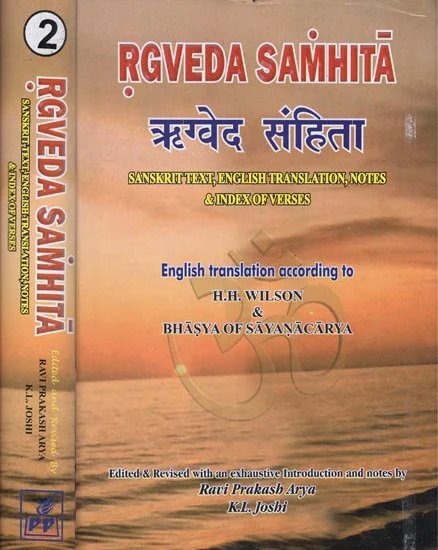Rig Veda (translation and commentary)
by H. H. Wilson | 1866 | 1,999,864 words | ISBN-10: 8171101380 | ISBN-13: 9788171101382
The Rig-Veda, English translation, including the commentary of Sayana and grammatical analysis. The hyms of the Rigveda Samhita represents some of the oldest and complex of Hindu Sanskrit literature. In ten books, these mantras form the core essence of rituals and ceremonies once widely performed throughout ancient India. This edition contains the...
Disclaimer: These are translations of Sanskrit texts and are not necessarily approved by everyone associated with the traditions connected to these texts. Consult the source and original scripture in case of doubt.
Rig Veda 8.8.23
Sanskrit text [Accents, Plain, Transliterated]:
त्रीणि॑ प॒दान्य॒श्विनो॑रा॒विः सान्ति॒ गुहा॑ प॒रः । क॒वी ऋ॒तस्य॒ पत्म॑भिर॒र्वाग्जी॒वेभ्य॒स्परि॑ ॥
त्रीणि पदान्यश्विनोराविः सान्ति गुहा परः । कवी ऋतस्य पत्मभिरर्वाग्जीवेभ्यस्परि ॥
trīṇi padāny aśvinor āviḥ sānti guhā paraḥ | kavī ṛtasya patmabhir arvāg jīvebhyas pari ||
English translation:
“The three wheels (of the chariot) of he Aśvins, which were invisible, have become manifest; do youtwo, who are cognizant of the past, (come) by the paths of truth to the presence of living beings.”
Commentary by Sāyaṇa: Ṛgveda-bhāṣya
Paths of truth:patmabhir = padair, wheels;
Ṛtasya = truth, water, or the sacrifice, which the paths or wheels are said to cause,satyasya udakasya yajñasya vā hetubhūtaiḥ padaiḥ
Details:
Ṛṣi (sage/seer): sadhvaṃśaḥ kāṇvaḥ [sadhvaṃśa kāṇva];Devatā (deity/subject-matter): aśvinau ;
Chandas (meter): virāḍārṣyanuṣṭup ;
Svara (tone/note): Swar;
Padapatha [Accents, Plain, Transliterated]:
त्रीणि॑ । प॒दानि॑ । अ॒श्विनोः॑ । आ॒विः । सन्ति॑ । गुइहा॑ । प॒रः । क॒वी इति॑ । ऋ॒तस्य॑ । पत्म॑ऽभिः । अ॒र्वाक् । जी॒वेभ्यः॑ । परि॑ ॥
त्रीणि । पदानि । अश्विनोः । आविः । सन्ति । गुइहा । परः । कवी इति । ऋतस्य । पत्मभिः । अर्वाक् । जीवेभ्यः । परि ॥
trīṇi | padāni | aśvinoḥ | āviḥ | santi | guihā | paraḥ | kavī iti | ṛtasya | patma-bhiḥ | arvāk | jīvebhyaḥ | pari
Multi-layer Annotation of the Ṛgveda
[Rigveda 8.8.23 English analysis of grammar]
[noun], nominative, plural, neuter
“three; tri/tisṛ [word].”
[noun], nominative, plural, neuter
“word; location; foot; footprint; pada [word]; verse; footstep; metrical foot; situation; dwelling; state; step; mark; position; trace; construction; animal foot; way; moment; social station; topographic point; path; residence; site; topic.”
[noun], genitive, dual, masculine
“Asvins; two.”
[adverb]
“openly; obviously.”
[?]
“_”
[adverb]
“secretly.”
[adverb]
“beyond; away; farther.”
[noun], nominative, dual, masculine
“poet; wise man; bard; Venus; Uśanas; kavi [word]; Kavi; prophet; guru; Brahma.”
[noun], genitive, singular, neuter
“truth; order; fixed order; ṛta [word]; law; custom; custom.”
[noun], instrumental, plural, neuter
“flight.”
[adverb]
“here.”
[noun], ablative, plural, masculine
“live; alive(p); amṛta.”
[adverb]
“from; about; around.”
